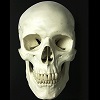6.5: Sex Estimation of the Pelvis
- Page ID
- 11461
The pelvis is an ideal anatomical structure to use in sex estimations of adult supcimens, because of the obvious functional relationship between the pelvic shape and reproduction in the female. Many studies have been done to determine pelvic characteristics useful in sex estimations. The most easily identified indicators will be mentioned in this text. The first two are generally the most useful, espeically for the budding osteologist. Clearly, the more experience an osteologist has in making sex estimations and the greater number and range of pelves examined, the better the estimations will be.
1. Sub-pubic angle. The inferior angel that the right and left pubic bones make when in articulation tend to be wider in females than in males; a wider angle produces a larger pelvic outlet. Angles closer to 90 degrees suggest male sex, while those 120 degrees and over would suggest a female. The female pelvis is shorter and broad to aid in the birthing process, since the male pelvis lacks this necessity it is slightly taller and more narrow.
2. Sciatic notch. A narrow sciatic notch is associated with a restricted pelvic outlet and is more commonly found in males; the sciatic notch of females tends to be wider.
3. Acetabulum. The acetabulum is larger in males, due to the larger size of the femoral head in males. As males are generally larger, the femur is larger to transmit the weight of the body.
4. Obturator foramen. The obturator foramen tends to be larger in males and rather oval in outline, whereas in females it is smaller and more triangular.
5. Pre-auricular groove. The pre-auricular groove is found in some individuals of both sexes but it tends to be irregularly pitted in females if the pelvic joint ligaments that attach there are stressed in childbirth, thus a pitted pre-auricular groove indicates an estimation of female sex. However, an absence of the groove or a non-pitted form does not indicate male sex.
6. Sacrum. The sacrum of the male tends to be relatively longer, narrow, and curved. On the other hand, the female sacrum is broader, short, and straight.
7. Pelvic inlet. The pelvic inlet of the male pelvis, when viewed from above with the ventral aspect facing you, will be heart shaped in appearance. The female pelvic inlet, when held in the same aspect, is described as elliptical in appearance.
8. Dorsal pitting. Pits or depressions located on the dorsal aspect of the pubis, near the pubic symphysis. One or more may be present. The pits have been associated with pregnancy; number of pits does not necessarily represent number of births but the process of stretching during the birthing process.
Sex Estimation of the Non- Pelvic Postcranial Bones
Sex estimation of the non-pelvic postcranial bones can be very difficult, based on research with accuracy well below 90%. Keep this in mind when employing sex estimation on these bones. However, if observing several of the bones of a single individual you will greatly increase your sex estimation accuracy. Those listed below offer the highest levels of accuracy.
Humerus - A vertical (superior/inferior) measurement of the head, and a transverse (anterior/posterior) measurement of the head can be used in sexing.
| Vertical | Transverse | |
| Female | 42.67 | 36.98 |
| Male | 48.76 | 44.66 |
Femur - A measurement of the greatest diameter of the femoral head may be useful in determining sex. Keep in mind there may be populational differences.
| Female | Probable Female | |
| White Femalea | <42.5 | 42.5 - 43.5 |
| Black Female* | 41.52 |
| Male | Probable Male | |
| White Malea | >47.5 | 46.5 - 47.5 |
| Black Male* |
47.17 |
a Stewart 1979:120
* Thieme 1957: Table 1


